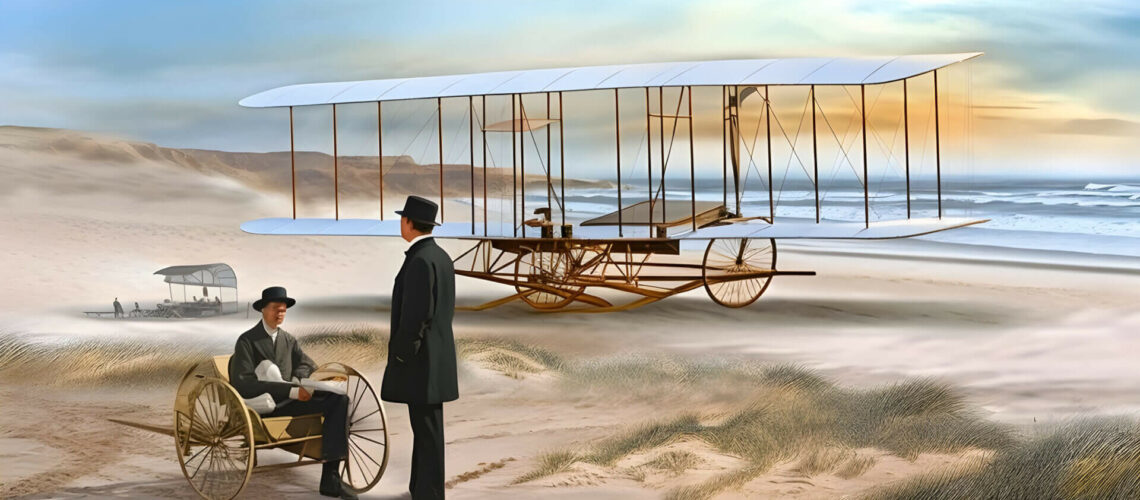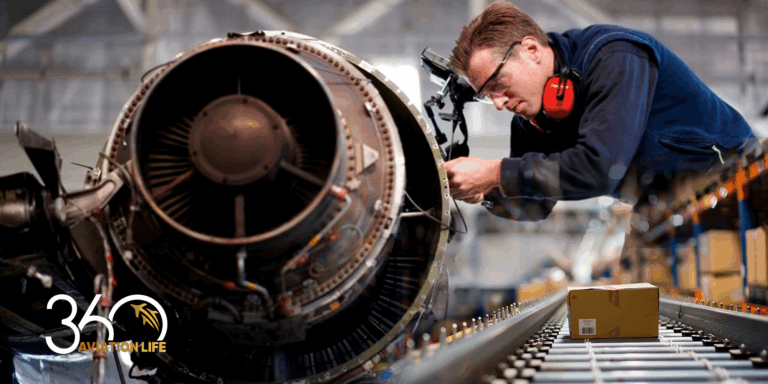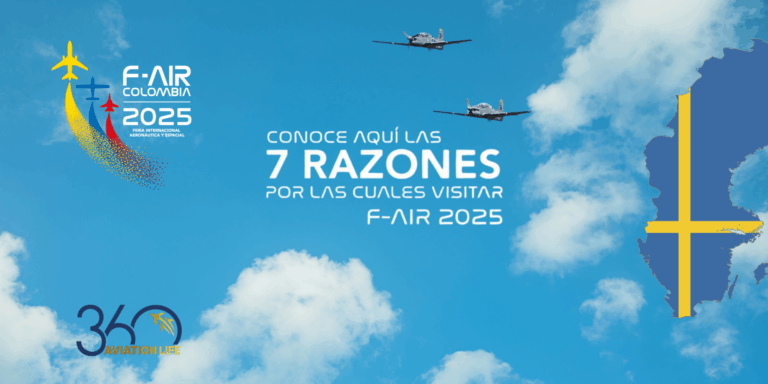Man’s longing for flight began early, when prehistoric man contemplated the flight of birds. Our desire to fly has been present for centuries and, throughout human history, there have been hundreds of attempts to emulate flying animals, most of which ended tragically.
But then, what was the first airplane in history? Who was the first human being to take to the skies? The history of aviation is not only the history of the airplanes we are used to, but also the evolution of an old dream of mankind, which is now entering another stage: space travel.
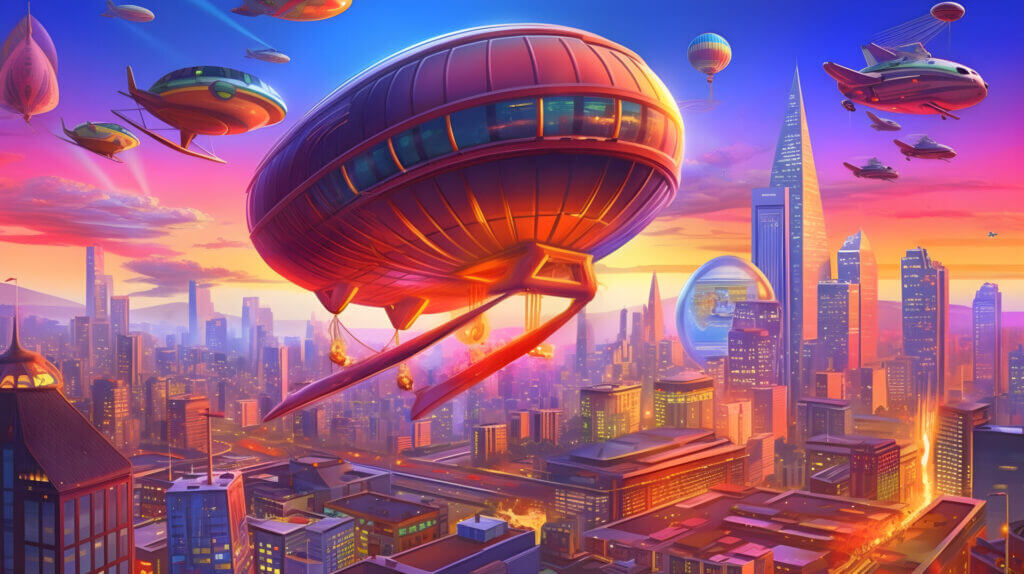
But today, in Aviation 360, we will look at the exciting history of aviation and how man’s desire to imitate birds led to today’s aircraft.
If you want to be part of the wonderful world of aviation and, why not, leave your mark in the history of airplanes, at Aviation 360 Life we can help you. Contact us today today or sign up for our courses. You can also visit our blog to keep up to date with the latest news from the world of aviation.
The origins of aviation
As we said, the origin of aviation goes back to prehistoric man, precisely when he looked up and observed the flight of birds, thus giving rise to his desire to imitate them.
There are records of flight or attempted flight from almost every era of human history, and flight is even known to be associated with higher beings in the mythology of various cultures. However, as with so many other human milestones, both the exact date and the pioneer who first managed to take flight aboard a heavier-than-air vehicle is shrouded in controversy.
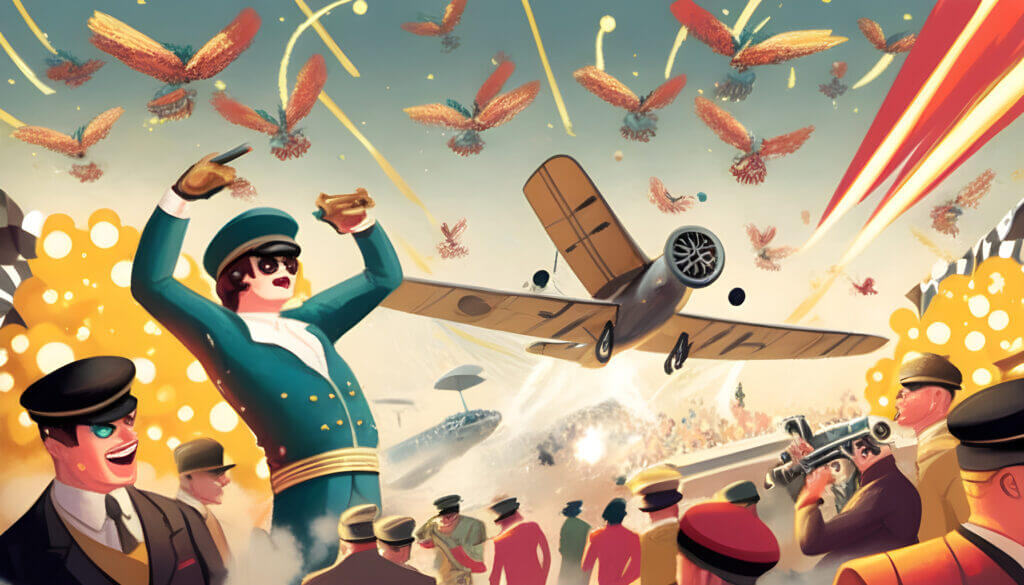
Throughout the history of aviation there have been multiple attempts to take to the skies, and to this day it is disputed who was the first man to take flight.
Although any informed person would say that the first flight in a heavier-than-air aircraft was that of Orville and Wilbur Wright in their Flyer I, on December 17, 1903 at Kitty Hawk (North Carolina), there were others who took flight before them, although without such success.
Let’s take a look at some of the most iconic early flights in aviation history.
Abbas Ibn Firnas: the first flight in the history of aviation?
Born in Ronda (Malaga, Spain) Abbas Ibn Firnas was an Andalusian proto-humanist, scientist and chemist born into a family of Berber origin whose ancestors probably participated in the conquest of the Iberian Peninsula at the time of the Umayyad Emirate in al-Andalus-Spain.
Firnas was also a pioneer of aviation and built the first human transport glider, which had a successful flight that made him the first human being in history to take flight, although with a not very happy ending. It is said that in the year 875 he jumped from a high place in Cordoba with wooden wings covered with silk and feathers. He apparently glided for about 10 seconds before falling and breaking both legs.
Today a crater on the Moon, an airport in Iraq and a bridge in Cordoba (Spain) bear his name, which was later Latinized as Armen Firman.
Leonardo da Vinci: a man ahead of his time
Both Abbas Ibn Firnas and many of his successors overlooked the fact that they needed a bird-like tail to land successfully. However, for centuries the flight of birds continued to inspire early pioneers in the history of aviation.
That’s how we come to the most famous of them: Leonardo da Vinci. The Florentine polymath of the Italian Renaissance needs no introduction and, although he never took flight, it was Leonardo who realized that human muscles were too weak to move wings and that a combination of arm and leg movement by means of pulleys was needed.
Thus, he built the Ornithopter, an aerodyne with movable wings that obtains the necessary thrust from the flapping movement of its wings in a similar way as birds do. However, this was never proven, so the contributions of the great Florentine polymath to the history of aviation, although invaluable, were largely theoretical.
The Montgolfier Brothers and the hot air balloon
The history of modern aircraft has an almost immediate antecedent in hot air balloons. This is how the French brothers Jaques and Joseph Montgolfier, inventors of this machine that since the end of the 17th century would mark a before and after in the world of aviation, entered the history of aviation.
Like many of mankind’s great inventions, the hot air balloon was discovered almost by accident, when Jaques and Joseph, sons of a paper manufacturer, were playing one day with inverted paper bags over the fire, discovering that the bags went up to the ceiling.

Thus it was that on June 4, 1783 they carried out their first public demonstration in which they raised a spherical linen bag lined with paper filled with hot air, 11 meters in diameter and weighing about 226 kilograms. It traveled 2 km in 10 minutes, reaching an estimated altitude between 1600 and 2000 meters.
But the Montgolfier brothers were not satisfied with this, and on September 19 they sent the first living creatures (a sheep, a duck and a rooster) in a basket attached to the balloon, to investigate the effects of the air at altitude. The fact that Louis XVI of France himself witnessed these tests, in order for the monarch to give his permission for a next human flight test.
Thus, on November 21, 1783, Pilâtre de Rozier and the Marquis d’Arlandes made the first human-crewed flight in the history of aviation. They flew for 25 minutes at about 100 meters over Paris, achieving a distance of nine kilometers to land south of the city, where the first aeronauts were hailed as heroes.
The history of modern aviation
Until the 19th century, there were numerous attempts to build flying machines, which were gradually detached from the bird model.
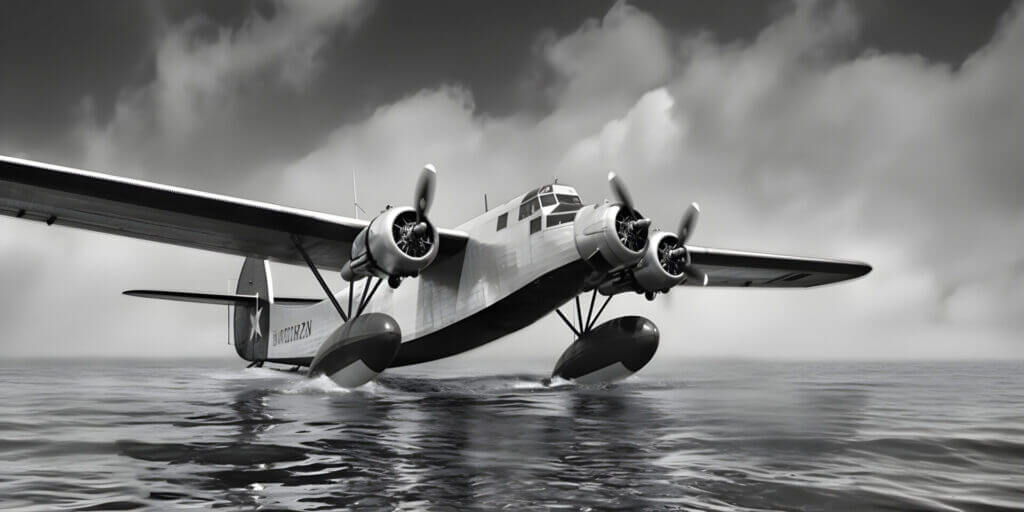
Thus, some inventors focused only on gliding, controlling the direction with the body. It is in this sense that Otto Lilienthal was one of the most influential engineers in the history of airplanes and, although he was not the father of the first airplane in history, he was in some ways its direct precursor.
Did you know that you too can be part of aviation history? Don’t wait any longer and take flight! Contact us right now at +356 9932 2489 . You can also log on to our blog to keep up to date with the latest news from the world of aviation and visit our website to find out more about our courses.
Otto Lilienthal: the “grandfather” of the first airplane in history
Otto Lilienthal was a German engineer and aviation pioneer who made important contributions to the development of aviation in the second half of the 19th century. Lilienthal was born in Anklam, Germany, in 1848 and from a young age showed a great interest in science and technology.
Throughout his career, Lilienthal built and tested more than 2,000 different gliders, which allowed him to develop a wealth of experience and knowledge in the field of aviation. In 1891, Lilienthal achieved his first glider flight, which allowed him to demonstrate that aerodynamics was fundamental to human flight.
Lilienthal was the first man to fly regularly in gliders, earning him the title “the father of gliding”. His work inspired many other aviation pioneers, including the Wright brothers, who drew on Lilienthal’s research and experiments to build their own aircraft.
Unfortunately, in 1896, Lilienthal suffered an accident while flying his glider, causing serious injuries that eventually led to his death. However, his legacy in the field of aviation continues to be recognized to this day.
But those who forever marked the history of aviation were the Wright brothers, who are already known worldwide as the creators of the first airplane in history.
Let’s learn a little more about this brother and sister duo that forever changed the history of airplanes.
The Wright Brothers: the fathers of the first airplane in history
Wilbur and Orville Wright were born in Ohio, USA, in 1867 and 1871, respectively, and from a young age showed a keen interest in mechanics and technology.
Throughout their career, the Wright brothers conducted a number of experiments and tests on aircraft, which allowed them to develop a wealth of experience and knowledge in the field of aviation. In 1903, they achieved a historic milestone by making the first controlled and sustained flight in an airplane at Kitty Hawk, North Carolina.
The aircraft they used on that flight was the Flyer I, an impressive machine for the time. The Flyer I had an innovative design and was constructed primarily of wood and fabric. It had a wingspan of 6.4 meters and weighed about 340 kilograms.
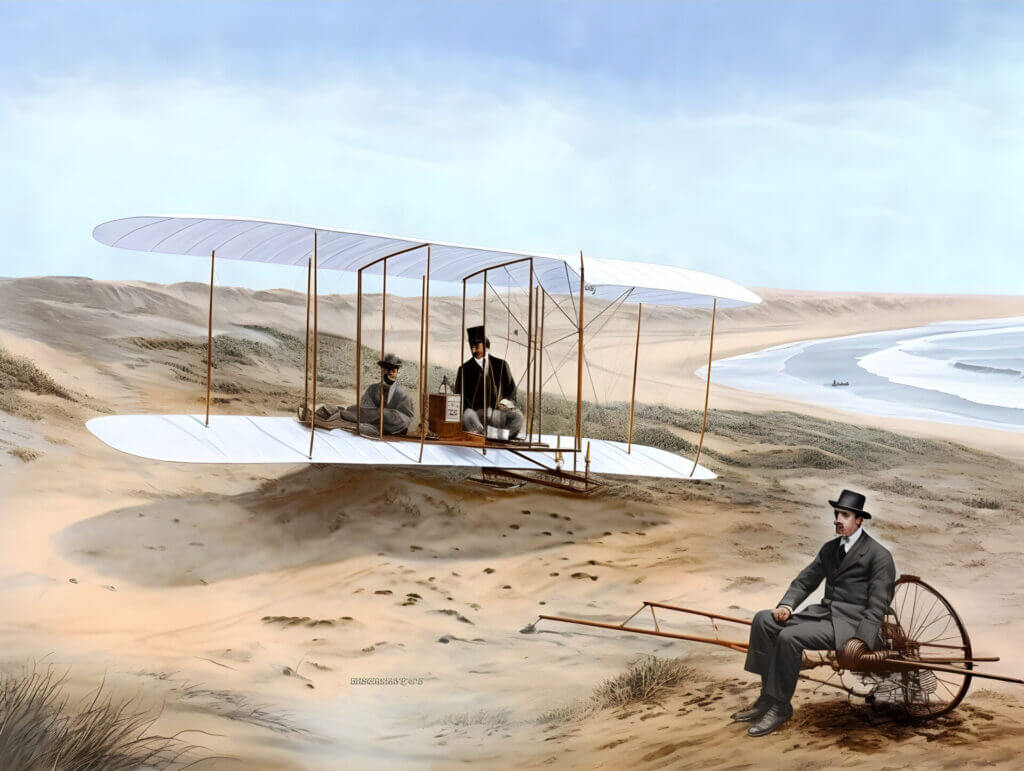
The Flyer I engine was a four-cylinder and produced about 12 horsepower. This engine powered two counter-rotating wooden propellers, which allowed the aircraft to maintain its balance in the air.
However, as happens many times throughout history, the Wright brothers were at first treated as geeks and con men, so no one wanted to sign any purchase contract until they saw the plane working. Stakeholders initially believed it was all a hoax because almost no one had seen them fly and, in addition, the common belief was that the brothers were geeks at the time with few friends in the media.
But this didn’t stop the Wrights and, on December 17, 1903, they made four flights in the Flyer I. The first flight lasted only 12 seconds and covered a distance of 36 meters but, on the fourth and final flight, Orville Wright managed to fly for 59 seconds and cover a distance of 260 meters.
This historic achievement marked the beginning of modern aviation and laid the foundation for the development of aviation worldwide. The Wright brothers continued to test and improve their aircraft and, in 1908, succeeded in making the first controlled and sustained flight in Europe.
It may be true that the Flyer I was a rudimentary airplane model that would be difficult to fly even by the experienced pilots that exist today, but was the first airplane in history that paved the way for what, many years later, would become the airplanes we know today.
Conclusion
In short, the Wright brothers are considered the pioneers of modern aviation and their aircraft, the Flyer I, is a milestone in aviation history. His work and experimentation in the field of aviation enabled the development of the aeronautical industry and opened the door to commercial air travel and space exploration.
However, without the work of his predecessors none of this would have been possible. The desire to fly has been at the heart of mankind for thousands of years, and this was the starting point of the history of aviation, which does not stop with the history of airplanes.
Without Abbas Ibn Firnas, without Leonardo da Vinci and the Montfilger Brothers, and without the invaluable contributions of Otto Lilienthal, the Wright Brothers would not be the fathers of aviation as we know it today, and in this brief tour we have had to overlook other great aviation pioneers who may not have the fame and renown of the Wrights, but whose contributions are invaluable.
For all these reasons, to know the history of aviation is to know the history of an old longing of mankind, which has passed from generation to generation and still today has much to offer to a humanity that can see beyond the sky.
With Aviation 360 Life you can be part of aviation history. Find out more about our courses and start your way in the wonderful world of aviation. For more information, please contact us at +356 9932 2489 or visit our blog for the latest news about the world of aviation.

